Estadi Olímpic Lluís Companys (Estadi Olímpic de Montjuïc)
| Capacity | 49 472 |
|---|---|
| 240 (VIP seats) | |
| 198 (Press seats) | |
| Country | Spain |
| City | Barcelona |
| Clubs | - |
| Inauguration | 20.05.1927 |
| Renovations | 1989, 2022 |
| Design | Pere Domènech i Roura (1927), Vittorio Gregotti (1989) |
| Address | Paseo Olímpico 17-19, 08038 Barcelona |
Advertisement
Estadi Olímpic Lluís Companys – stadium description
Why was Estadi Montjuïc built?
Estadi Montjuïc in Barcelona was designed by Pere Domènech, son of the famous Catalan architect of the modernism period, Lluis Domènech i Montaner. One of the main objectives of the construction was to prepare Barcelona to host the 1929 International Expo.
Construction of the stadium also began in 1927 with a view to hosting the Barcelona Olympic Games. Despite three attempts (in 1920, 1924 and 1936), none of the candidatures were successful. It was only on the fourth attempt, in 1992, that Barcelona fulfilled its dream of hosting the Olympic Games.
The stadium was officially opened on May 20, 1929 with a rugby match between Spain and Italy, three qualifying rounds of the 100 metres run and a football match between the Catalan national team and Bolton Wanderers.
How has the name of Barcelona's Olympic Stadium changed over the years?
Initially, the stadium was called Estadio de Montjuïc. In 1989, the member Olympic
was added to the name, transforming it into Estadio Olímpico de Montjuïc. In 2001, the stadium was named after Lluís Companys, a Spanish politician and lawyer who was captured and executed by the Franco regime. This name still functions today.
Where is Estadi Olímpic Lluís Companys located?
Barcelona Olympic Stadium is located in the Sants-Montjuïc district, on Montjuïc Hill, within the L'Anella Olímpica de Montjuïc Olympic Park. It is located in the south-east of the city, a short distance from the Catalan beaches and the Castell de Montjuïc castle. The stadium is well connected, with the Barcelona-Terminal F3 train station, the metro and the B-10 bypass nearby.
What did first Estadi Olímpic Lluís Companys look like?
The stadium was designed with great attention to detail, with numerous monumental touches such as towers, gates and monuments. The grandstands of the venue were in the shape of two semicircles, connected by straight lines, reminiscent of the Roman constructions of hippodromes and amphitheatres. Inside there was an athletics track and field, oriented on a north-south axis.
The stadium, when completed, could hold 62,728 spectators, making it one of the largest sports venues in the world at the time. The cost of construction was 65 million pesetas.
How was Estadi Montjuïc rebuilt for the 1992 Olympic Games?
On 17 October 1986, Barcelona was chosen to host the 1992 Olympic Games. As the stadium had been unused for many years, modernisation became inevitable. The renovation work took place between 1985 and 1989.
The entire infrastructure of the stadium was comprehensively renovated, its capacity was increased, the turf and athletics track were rebuilt and new double-decker stands were added. The level of the original running track was lowered by 11 metres, and the foundation stone from the first construction was used to build the Sagrada Família temple. The only element that remained intact was the stadium's facade - a symbol of Barcelona's historic Olympic heritage.
The second opening of the stadium took place on September 8, 1989, during the 5th World Athletics Championships. In 1992, the stadium was the arena for the opening and closing ceremonies of the Olympic and Paralympic Games, as well as athletics competitions.
Who has played at Estadi Olímpic Lluís Companys?
The stadium does not belong to any Barcelona football club and is not used permanently by any team. However, three teams have played here periodically over the last 100 years. The first was the Barcelona Dragons, an American football team that played matches in the World League of American Football and NFL Europe from 1991 to 2003. After changing their name to FC Barcelona Dragons in 2003, the team moved to the Mini Estadi at the Camp Nou complex.
Football teams played here temporarily while their home stadiums were being rebuilt. After the historic Estadio de Sarrià was demolished in 1997, Espanyol played matches at Montjuïc until 2009, when Estadio Nou Sarrià was completed. For the duration of the construction of new Camp Nou, from 2022 onwards, the Catalan Pride play their matches at the Olympic Stadium in Barcelona. The likely date of return to Camp Nou is early 2025.
How has Estadi Montjuïc been adapted for FC Barcelona?
Barcelona's Olympic Stadium has once again undergone a facelift ahead of FC Barcelona's arrival. As part of the project, several areas of the stadium were transformed including the hospitality rooms, press stands, changing rooms and pitch. The drainage, irrigation and water treatment systems were upgraded and a new water tank was installed. In addition, the competition broadcast and television systems were upgraded to meet the requirements of La Liga and international competitions.
Other significant improvements include modern lighting, telecommunications networks, commentator sectors, VIP seating and the implementation of advanced systems such as VAR and tracking cameras.
The Barcelona authorities have also improved public transport running around the arena. New bus lines have been created, and the length of the metro line commuting to the area has been extended. A cycle path has been built between Plaza España and Miramar and the lighting systems in the pedestrian walkways leading to the venue have been replaced.
What does Estadi Olímpic Lluís Companys look like?
Estadi Olímpic Lluís Companys has a multi-purpose character and is equipped with an athletics track. The track is surrounded by two-tiered stands. The lower tier of the auditorium has a classic, gently contoured oval shape that matches the contour of the runway. The upper tier has a slightly different form, straight along the pitch and rounded at the curves.
However, the seemingly incompatible two tiers of stands form a harmonious, symmetrical whole. Richly decorated facades and horse sculptures add to the aesthetics of the stadium. Particularly noteworthy is the palatial facade of the main (west) stand with a central dome and bell tower on the side. Also emblematic is the monumental marathon gate on the northern curve.
Only the main stand has a canopy. The facility is also equipped with artificial lighting. Floodlights have been placed on several poles spread behind the east stand and in the corners, as well as in the roof over the main stand. There is a video screen and an electronic scoreboard on the southern curve.
What sporting events have taken place at Estadi Olímpic Lluís Companys?
The most important event was definitely the 1992 Olympic and Paralympic Games. The stadium also hosted the 1955 Mediterranean Games. In addition, the World Championships in Athletics (1989), the European Championships in Athletics (2010) or the World Junior Championships in Athletics (2012) were held here. Montjuic has hosted 22 national finals in athletics.
The stadium has also played host to American football teams, rugby teams, or hosted the X-Games, Snow Show, boxing fights, fencing, hockey, motor sports competitions, urban running events (Cursa dels Nassos, Cursa Lluís Companys, Breakfast Run, Cursa de El Corte Inglés...).
The stadium has also hosted football matches. From 1997 to 2009 Primera Division matches, and from 2022 to 2024 La Liga matches. Montjuic played host to King's Cup finals in 1930, 1933, 1934, 1939, 1944, 1945, 1946, 1957 and 2004. It also played host to Spanish Super Cup matches 1996, 2000 and 2006. 8 matches were played here by the Spanish national team, all of which were friendly matches.
What non-sporting events took place at Estadi Olímpic Lluís Companys?
After the Games, the stadium became an arena for numerous cultural and business events. Major international concert tours have taken place there, as well as municipal and business initiatives. Over the years, more than millions of spectators have attended the more than 1,000 events that have taken place at the stadium since 1990.
Some of the biggest artists to have performed at Montjuïc have included Michael Jackson, Madonna, Rolling Stones, Bruce Springsteen, Bon Jovi, Beyoncé, Ed Sheeran, AC/DC, Guns N' Roses, Metallica, Shakira, Bruno Mars, Coldplay, Harry Styles and The Weeknd.
The stadium was also the site of the Barcelona International Exhibition (1929-1930), a refuge for refugees during the 1936 Civil War, and served as a shelter during the 1957 and 1958 Barcelona floods. The stadium has been used for religious ceremonies and was the venue for driving tests in 1965.
Advertisement
Pictures
-

12.11.2023 © Stadionvoyeur 
12.11.2023 © Stadionvoyeur 
12.11.2023 © Stadionvoyeur 
29.09.2023 © MM Groundhopping 
29.09.2023 © MM Groundhopping 
04.2024 © Alecaom 
29.09.2023 © MM Groundhopping 
29.09.2023 © MM Groundhopping 
29.09.2023 © MM Groundhopping 
12.11.2023 © Stadionvoyeur 
12.11.2023 © Stadionvoyeur 
12.11.2023 © Stadionvoyeur 
12.11.2023 © Stadionvoyeur 
12.11.2023 © Stadionvoyeur 
12.11.2023 © Stadionvoyeur 
12.11.2023 © Stadionvoyeur 
12.11.2023 © Stadionvoyeur 
12.11.2023 © Stadionvoyeur 
28.11.2023 © brucki.blogspot.com 
28.11.2023 © brucki.blogspot.com 
28.11.2023 © brucki.blogspot.com 
29.09.2023 © MM Groundhopping 
29.09.2023 © MM Groundhopping 
29.09.2023 © MM Groundhopping 
29.09.2023 © MM Groundhopping 
28.11.2023 © brucki.blogspot.com 
29.09.2023 © MM Groundhopping 
28.11.2023 © brucki.blogspot.com 
28.11.2023 © brucki.blogspot.com 
28.11.2023 © brucki.blogspot.com 
09.2004 © Amadalvarez (cc: by) 
17.06.2008 © Justin-Scott Salvador (cc: by-nc-nd) 
04.03.2012 © Michał Koliba 
04.03.2012 © Michał Koliba 
04.03.2012 © Michał Koliba 
04.03.2012 © Michał Koliba 
04.08.2011 © Volkanikz (cc: by) 
04.08.2011 © Volkanikz (cc: by) 
04.03.2012 © Michał Koliba 
04.03.2012 © Michał Koliba 
26.06.2011 © Ekaterina Lokteva 
26.06.2011 © Ekaterina Lokteva 
21.03.2011 © Aerismaud (cc: by-nc-nd) 
09.04.2011 © dasoaz (cc: by-nc-nd)
pre 2023/2024:
Related news
2025
-

Spain: Growing doubts over the organisation of the Catalonia – Palestine match at Montjuïc
Two weeks before the historic match between Catalonia and Palestine, whose proceeds are intended to support the reconstruction of the Gaza Strip, ticket sales still have not started, and organisers warn that the match may be moved to a smaller stadium outside Barcelona.
-

Spain: Did Barcelona hire the worst-rated contractor? Fight to reopen in 2025
Limak won the contract to rebuild Spotify Camp Nou despite receiving the lowest technical score, with the schedule becoming the decisive factor. FC Barcelona defends the choice, but the Espai Barça project now faces serious delays and key construction stages remain unfinished.
-

Spain: Barcelona launches 2025/26 season passes - one card for two stadiums
Barcelona has launched the sale of season tickets valid for both Estadi Olímpic Lluís Companys and Spotify Camp Nou once it reopens. This transitional solution will remain in effect until the end of the season, while the team awaits a full return to Camp Nou.
-

Spain: Barcelona to face one-year delay at Camp Nou
It didn't happen in August, it didn't happen in September, and in October... FC Barcelona itself gave up on trying to return to Camp Nou, which means that the delay compared to what was promised will reach one year. There are three official reasons for this.
-

Spain: Barcelona not returning to Camp Nou yet. One year of delay?
The match against Olympiacos in the Champions League will not be held at Camp Nou but once again at the Olympic Stadium Lluís Companys. The club has still not obtained the necessary permits, and the return to the renovated venue remains without a set date.
-
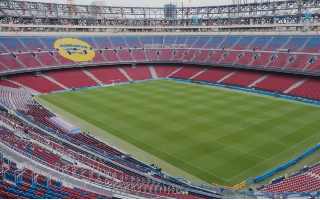
Spain: No approval to reopen Camp Nou. Barça moves to Montjuïc
After nearly two and a half years of reconstruction, FC Barcelona invited the media for the first tour of the renovated Spotify Camp Nou. Although the venue has undergone major changes, the City Council has refused to grant the club permission to host a match this coming Sunday.
-

Spain: It’s official – Barcelona vs PSG won’t be played at Camp Nou
Problems with the readiness of Barcelona’s new stadium, Spotify Camp Nou, continue. The club has still not received the necessary permits to open the venue, so the board is exploring alternative solutions. FC Barcelona has officially announced that the Champions League match against PSG scheduled for 1 October will take place at Estadi Olímpic Lluís Companys.
-

Spain: FC Barcelona to play again at Estadi Johan Cruyff
FC Barcelona have confirmed that their LaLiga Matchday 5 clash with Getafe, set for Sunday 14 September at 21:00, will be staged at the Estadi Johan Cruyff.
-

Spain: Barcelona defends itself against criticism after another Camp Nou fiasco
"We have worked day and night" assures FC Barcelona's board, blaming the delay on complicated administrative processes. Although Laporta assures that "the stadium is now complete", he refused to give a new planned return date for the return. The opposition inside the club is growing stronger.
-
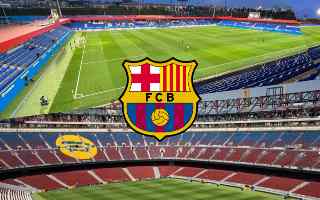
Spain: Camp Nou or Johan Cruyff? Barça awaits a decision
This is the week when FC Barcelona are due to play their first home game of the 2025/26 season. Yet it is still unclear which stadium will host the match. A final decision is expected to be taken and announced on Tuesday afternoon, after another – though not decisive – inspection of work at Spotify Camp Nou by the club’s management.
-

Spain: FC Barcelona broke the law in rush to have Camp Nou ready
At a key moment of the reconstruction, the Urban Guard stopped the works for a breach of the schedule. Barcelona still hopes to kick off both La Liga and Champions League matches at the Camp Nou, but despite the progress made, the club does not yet have the necessary permits.
-

Spain: Barça chooses second team’s Estadi Johan Cruyff!
FC Barcelona ruled out Montjuic and Montilivi for the start of La Liga, and in the absence of permission to open the Camp Nou, chose the home of their reserve team. La Liga has already inspected the venue, but the insufficient capacity of the Estadi Johan Cruyff could be a problem.
-
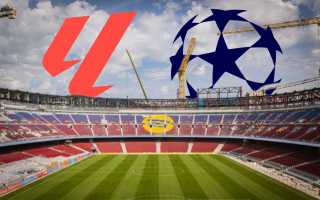
Spain: Barça obtains an essential certificate for Camp Nou and is left with 3 options
FC Barcelona have reportedly obtained the Certificate of End of Works, thus beginning the process of obtaining the necessary permits to return to the Camp Nou. However, it is not clear that the stadium will be ready for the Barça-Valencia game scheduled September 14, and the club is left with three options: Camp Nou, Estadi Montjuic or Estadi Montilivi.
-

Spain: Camp Nou removed as Barça’s venue for the Valencia match
FC Barcelona still hopes to return to the renovated Spotify Camp Nou in September, but at the same time the club has prepared a backup plan in case of further delays. Moreover, the club’s website has already removed Camp Nou as the venue for the match against Valencia, replacing it with “TBC.”
-
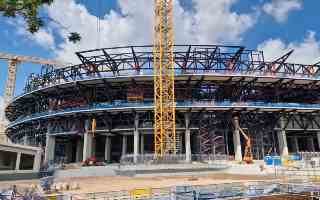
Spain: Barcelona is fighting to return to Camp Nou. Still, the club has a backup plan
FC Barcelona is counting down the days to the scheduled return to Camp Nou. The problem is that the stadium still lacks the required permits, and some construction work remains unfinished.
-

Spain: 10 days until final decision on Camp Nou, Monday will be crucial
The Camp Nou must be ready by August 28 for FC Barcelona to play the Champions League there. The Blaugrana team wants to receive a certificate of completion on Monday so that permits can be obtained in time.
-

Spain: Spotify pressures Barça. Camp Nou’s future unclear, minimal section for ultras
FC Barcelona is counting down the days to the start of the new La Liga season in front of its home fans, but the return is still uncertain. The stadium’s renovation faces further delays, the club is struggling to obtain an operating license, and relations with its main sponsor remain tense.
-
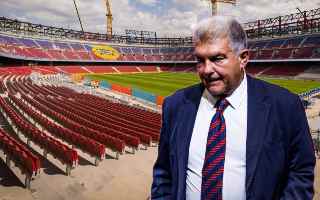
Spain: Years of promises at Camp Nou – every mistake made by Laporta
From the very beginning, the redevelopment of Camp Nou took shape as a never-ending story. Although FC Barcelona repeatedly announced their return to the stadium, each new chapter of this saga ended in a broken promise. What did this journey look like from the very start?
-

Spain: Barcelona awaits Camp Nou. Mayor says no, Laporta asks UEFA for a favor.
The return to Spotify Camp Nou was one of the biggest topics in July. Although FC Barcelona had announced that the Gamper Trophy match would be played on the newly renovated stadium in Les Corts on August 10, just 23 days later the club backed out, stating that the return would have to be postponed.
-
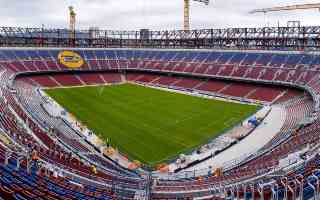
Spain: No Camp Nou comeback for Gamper Trophy match
The Joan Gamper Trophy match, in which FC Barcelona will face Italian side Como on Sunday, August 10, coached by Cesc Fàbregas, will ultimately be played at the Estadi Johan Cruyff.

 StadiumDB
StadiumDB